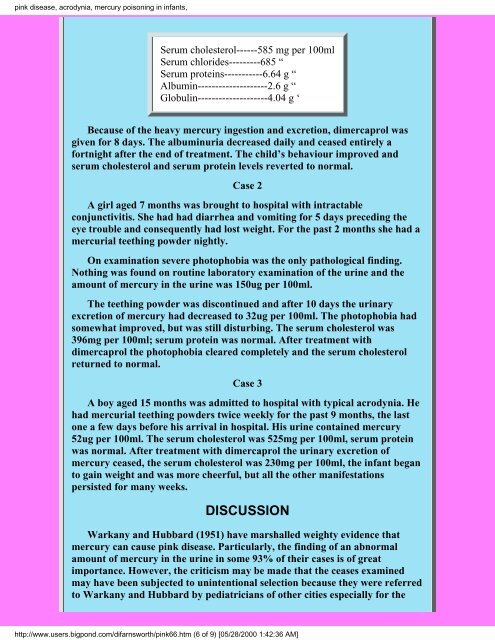Create successful ePaper yourself
Turn your PDF publications into a flip-book with our unique Google optimized e-Paper software.
pink disease, acrodynia, mercury poisoning in infants,Serum cholesterol------585 mg per 100mlSerum chlorides---------685 “Serum proteins-----------6.64 g “Albumin--------------------2.6 g “Globulin--------------------4.04 g ‘Because of the heavy mercury ingestion and excretion, dimercaprol wasgiven for 8 days. The albuminuria decreased daily and ceased entirely afortnight after the end of treatment. The child’s behaviour improved andserum cholesterol and serum protein levels reverted to normal.Case 2A girl aged 7 months was brought to hospital with intractableconjunctivitis. She had had diarrhea and vomiting for 5 days preceding theeye trouble and consequently had lost weight. For the past 2 months she had amercurial teething powder nightly.On examination severe photophobia was the only pathological finding.Nothing was found on routine laboratory examination of the urine and theamount of mercury in the urine was 150ug per 100ml.The teething powder was discontinued and after 10 days the urinaryexcretion of mercury had decreased to 32ug per 100ml. The photophobia hadsomewhat improved, but was still disturbing. The serum cholesterol was396mg per 100ml; serum protein was normal. After treatment withdimercaprol the photophobia cleared completely and the serum cholesterolreturned to normal.Case 3A boy aged 15 months was admitted to hospital with typical acrodynia. Hehad mercurial teething powders twice weekly for the past 9 months, the lastone a few days before his arrival in hospital. His urine contained mercury52ug per 100ml. The serum cholesterol was 525mg per 100ml, serum proteinwas normal. After treatment with dimercaprol the urinary excretion ofmercury ceased, the serum cholesterol was 230mg per 100ml, the infant beganto gain weight and was more cheerful, but all the other manifestationspersisted for many weeks.DISCUSSIONWarkany and Hubbard (1951) have marshalled weighty evidence thatmercury can cause pink disease. Particularly, the finding of an abnormalamount of mercury in the urine in some 93% of their cases is of greatimportance. However, the criticism may be made that the ceases examinedmay have been subjected to unintentional selection because they were referredto Warkany and Hubbard by pediatricians of other cities especially for thehttp://www.users.bigpond.com/difarnsworth/pink66.htm (6 of 9) [05/28/2000 1:42:36 AM]


